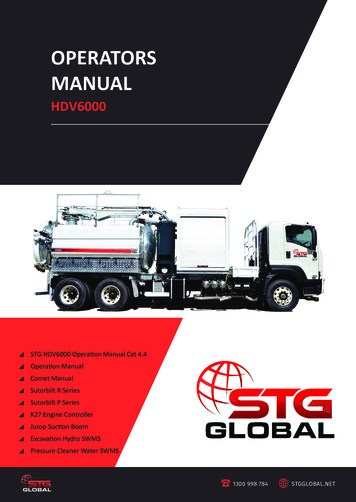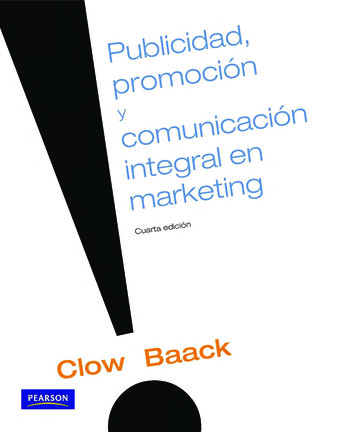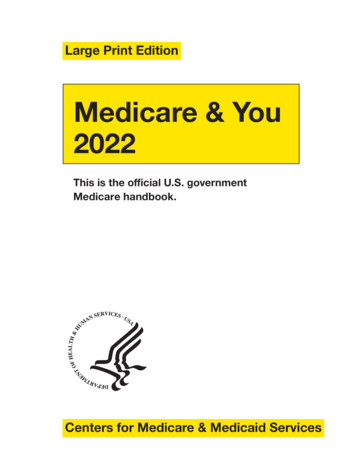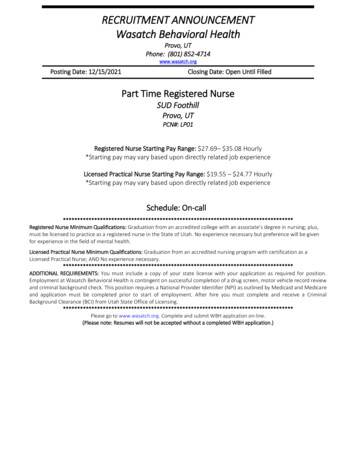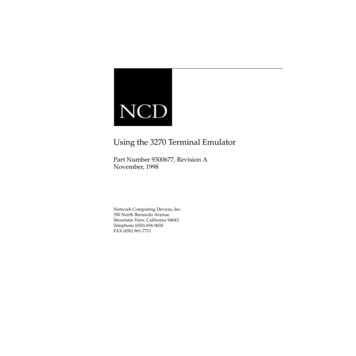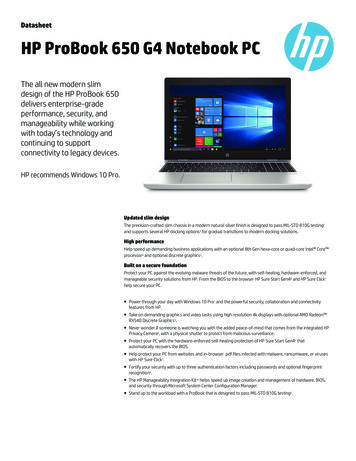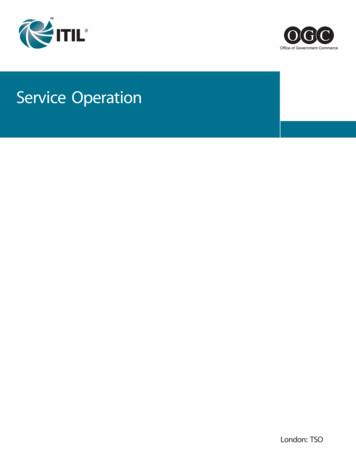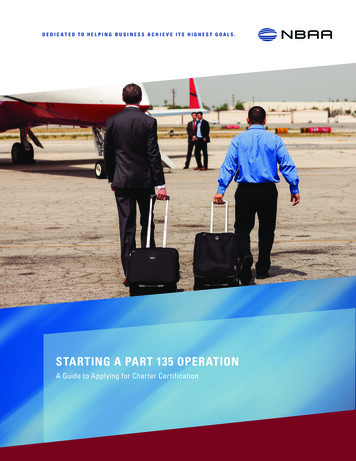
Transcription
NBAA MEMBERSHIPD E D I C A T E D T O H E L P I N G B U S I N E S S A C H I E V E I T S H I G H E S T G O A L S.STARTING A PART 135 OPERATIONA Guide to Applying for Charter Certification1 Pilot Records Improvement Act Guide
NBAA MEMBERSHIPTable of ContentsIntroduction. 2Assembling Your Application Package. 2Types of Part 135 Certificates. 3Five Phase Application Process. 3Other Approvals/Certifications. 5FSIMS Resources. 5IntroductionThose who wish to fly passengers for compensation or hire are expected to demonstrate their ability to operate to the highest level of safety. Operators who wish to fly passengers on-demand, rather than on a scheduled basis, must demonstratethis ability by complying with the regulations in 14 CFR 119, which applies to the certification of air carriers and commercialoperators, and 14 CFR 135, which contains the operating requirements for commuter and on demand operations.The process of applying for a 135 operating certificate can be daunting to those who have never been through it. “Starting a Part 135 Operation” is intended to simplify the process and help operators understand what will be required of themthroughout it. Based off FAA regulations and resources, this resource breaks down the types of 135 operating certificatesand provides guidance on what may be required to achieve certification. While it provides an overview of the process, it isnot intended to replace the specialized advice and expertise of an experienced professional.As a first step, NBAA recommends setting up an initial meeting with the local FAA Flight Standards District Office (FSDO), tolet them know you intend to begin the certification process. Developing a strong relationship with the FSDO doesn’t guarantee success, but it can often make the process smoother. By utilizing this guide, Advisory Circular 120-49, Certification ofAir Carriers and professional expertise, applicants should be able to develop a complete application package.Assembling Your Application PackageTo expedite the certification process, applicants should review the following information, assemble the required documentsand submit a complete and thorough package to the Flight Standards District Office (FSDO) that has jurisdiction in yourregion. The following highlighted sections serve as a checklist, with links in each to relevant sample documents, programs orforms. Please note that sample letters and programs may need to be modified to reflect your individual information. When allrequired sections are complete, or if you need any additional assistance, contact the FSDO nearest you.Types of Part 135 CertificatesAll on-demand operations are not made equal, and federal regulations are designed to be more stringent for those conductinghigher-risk flights. For example, an owner-pilot chartering a single seat turboprop in the Midwest will face significantly different risks than an operator chartering out a fleet of turbine aircraft for worldwide operations. To reflect this, the FAA createddistinct levels of Part 135 Certificate to match the needs and risk levels of different operations: “Ten or more” 135 Operator: Approved to operate aircraft with fewer than 30 passenger seats and a payload less than7,500 pounds. “Full” Part 135 Operator: No limitations on number of aircraft and pilots. May only operate aircraft with nine or less seats,but may obtain approval for worldwide operations.STARTING A PART 135 OPERATION 2
NBAA MEMBERSHIP Basic Part 135 Operator: Limited to a maximum of five pilots, including SICs. May not operate any more than five totalaircraft, consisting of not more than three aircraft types. Not allowed to conduct CAT II/CAT III operations and mustconduct operations within the United States, Canada, Mexico or Caribbean with aircraft that have nine or less seats.(Limited to aircraft with nine or fewer passenger seats.) Single Pilot-in-Command: Allowed one PIC and up to five SICs. All crewmembers are named in the Operations Specifications. Not allowed to conduct CAT II/CAT III operations and must conduct operations within the United States, Canada,Mexico or Caribbean with aircraft that have nine or less seats. Deviation from requirements for management personnel,company manuals, and training programs. Single-Pilot: Limited to one pilot who must be named in the Operations Specifications. Deviation from requirements formanagement personnel, company manuals and training programs.Commuter/Scheduled Operations: An on-demand operator may conduct scheduled flights in an airplane under these limitedconditions:1.2.3.4.The airplane used must be piston-powered or turbo-prop (i.e. not turbojet);The airplane used must have a maximum seating capacity of 9 passenger seats or fewer;The airplane used must have a maximum payload of 7,500 pounds or less; andThe operator is limited to conducting fewer than five round trips per week between any two points.The air carrier that conducts commuter operations under part 135 must obtain the Operations Specifications paragraphslisted in §119.49.Five-Phase Application ProcessThe certification process employs a “gate system” that requires the completion of certain items before beginning the nextstep. While smaller operations with less complexity may be eligible to use a modified certification process, all applicantsshould be thoroughly familiar with the five-phase application process, and applicable Federal Aviation Regulations (FARs).1.Pre-application Phase: Initial inquiries about certification or requests for application may be in writing or in the form ofmeetings with FSDO personnel. Pre-application Statement of Intent (PASI): This form must be completed by all applicants and submitted to the FAA.Detailed instructions for completing this form can be found in Appendix 1 of AC120-49.2.Formal Application Phase: A formal application letter must be completed by all applicants and submitted to the FAA. Asample letter is provided. Choose the correct FSDO and fill in the required information as indicated. Additional informationdetailing the contents of a formal application letter can be found in AC120-49 and FSIMS 2-347. Statement of Compliance: A letter of compliance (LOC) must be developed by all applicants and submitted to theFAA. The development of the LOC is typically the most time-consuming portion of the certification process. Applicantsshould read each relevant FAR and the corresponding sample statement, then revise the sample statement, if necessary, to describe how the applicant will comply with each regulation.3.Document Compliance Phase General Operations Manual (§135.23): Applicants that utilize more than one pilot in their operation will need to submita General Operations Manual (GOM) containing the information required by Part 135.21. General Maintenance Manual (§135.427): Required by operating utilizing aircraft with ten or more passenger seats. Deviations: If the applicant requests any deviations where the rule allows it (Parts 119.69, 135.21 and 135.341) mustbe submitted to the FAA for evaluation in letterform. Exemptions: Any exemption requests by an applicant must be accomplished in accordance with Part 11.25. Ground Deicing Program & Training (§135.227): Applicants intending to operate aircraft in ground icing conditionsmust develop a training program for approval. Information on developing a ground de-icing program is provided. Part 135 Training Program (§135.341): Applicants that utilize more than one pilot in their operation will need to submit atraining program for approval containing the information required by the FARs.STARTING A PART 135 OPERATION 3
NBAA MEMBERSHIP Management Personnel (§119.69): Applicants utilizing more than one pilot must submit a resume for the director ofoperations, chief pilot and director of maintenance indicating the qualifications set forth in §119.71. Pilot Resume to include Total Pilot Hours (§135.63): All applicants must submit a pilot resume in the certification package indicating that their work history and flying experience meets Part 135 requirements. Corporation Papers: If a corporation makes the application, the FAA must have a copy of the Certificate of Incorporation by the state and any accompanying documentation to evaluate applicant’s eligibility. Pilot Certificate & Medical Certificate: All applicants must provide a copy of the pilot certificate and medical certificateduring initial certification. Exclusive Use of One Aircraft (§135.25): Applicants must have exclusive use of at least one aircraft (six-month minimum) for each type of operation authorized. All applicants must provide a copy of the aircraft registration for the aircraftto be used and a copy of a lease agreement if the applicant does not own the aircraft. HazMat Procedure Manual & Training Program (§135.23(p)): All applicants must provide a copy of the proceduresmanual and a training program if they intend to carry HazMat and, if so, must also submit a procedures manual andtraining program for the recognition of HazMat. This manual should be provided upon request from your PrincipalOperations Inspector (POI). The requirements for a HazMat Training Program are outlined in 14 CFR Part 135, SubpartK. Carriage of HazMat is authorized with Operations Specifications paragraph A055. The FAA Security Division cananswer questions or supply additional information concerning HazMat regulations. Antidrug and Alcohol Misuse Prevention Program: All employees in a safety-sensitive position must be enrolledin an approved Drug and Alcohol Abatement Program in accordance with 14 CFR Part 120 and 49 CFR Part 40. Theprogram will be approved in Operations Specifications paragraph A449. Minimum Equipment List (§135.179): If the applicant wishes to operate with inoperable equipment it may only be accomplished in accordance with a MEL, examples of which are provided. PAX Briefing Card (§135.129(d)): Applicants must provide a passenger briefing card for each occupied passenger seat.Information is provided for the development of passenger briefing cards. Aircraft Discrepancy Log (§135.65): All applicants must develop an aircraft discrepancy log to be utilized by the pilot. Flight & Duty Records (§.135.63): All certificate holders are required to keep documentation of training and flight andduty times. Pilot Records Improvement Act of 1996 (PRIA): PRIA requires all Part 121 and Part 135 air carriers to request,receive and evaluate certain performance and safety records before allowing an individual to begin service as a pilot.More information about complying with PRIA can be found in NBAA's PRIA Guide. Department of Transportation (DOT) Economic Authority: If the applicant conducts interstate operations (across stateline) or transports mail they must apply for economic authority from the Department of Transportation in accordancewith 14 CFR Part 298. Applicants should complete and submit DOT Form OST-4507 along with an aircraft liabilityinsurance certificate (OST Form 6410), which is completed by the applicant’s insurance company or broker.4.Demonstration and Inspection Phase Pilot Training and Checking: In accordance with 14 CFR Part 135, Subpart H, each pilot must undergo training in compliance with the approved Part 135 Training Program. A series of checkrides will be given to evaluate the pilot’s knowledge, skills and abilities to act as a crewmember under Part 135 operations. Aircraft Conformity Inspection: Aircraft being utilized in Part 135 operations must undergo a conformity inspection bythe FAA. The conformity inspection checklist contains all the required information that will be verified by the FAA during initial certification. FAA provides the Form for Adding an Aircraft to 14 CFR Part 135 Certificate to use in conjunctionwith Aircraft Conformity Inspection Checklist. Aircraft Proving Runs (§135.145): If required, the operator must fly the aircraft 25 hours with FAA Inspectors onboard.The POI may approve a deviation from this regulation.5.Certification Phase Operations Specifications: The Principal Inspectors will issue the operator a series of Operations Specifications.These “OpsSpecs” contain the air carrier’s authorizations and limitations, as well as any document references. Air Carrier Certificate: The FSDO will issue an FAA Air Carrier Certificate.STARTING A PART 135 OPERATION 4
NBAA MEMBERSHIPOther Approvals/CertificationsIn addition to approval from the FAA to operate as a commercial operator, there are other approvals and/or certifications thatmay be required to ensure compliance with the various government agencies and foreign laws. Transportation Security Agency (TSA) Twelve-Five Standard Security Program (TFSSP): The “12-5 Program” is a security program required by all commercial air operators utilizing aircraft with a MGTOW of more than 12,500 pounds.Customs and Border Protection Customs Bond: A required bond for commercial operators entering the country from aforeign destination.Canada Foreign Air Operator Certificate (FOAC) and License: Air operator certificate and Operations Specifications toconduct non-scheduled international service in Canada.EASA Third-Country Operator (TCO) Certificate: Air operator certificate to conduct commercial air transport operationsin Europe.FSIMS ResourcesFSIMS is the Flight Standards Informational Management System, created by FAA Order 8900.1. The FSIMS was createdas a repository for documentation essential for the Aviation Safety Inspector. This publication is an electronic documentationsystem that the FAA adopted to replace the legacy “inspector’s handbook”. The publication is approximately 8,000 pages ofnon-regulatory guidance and policy that is essential for tasks of the Safety Inspector.The following information is used by FAA Inspectors as guidance information during the certification process. This informationwould be very valuable to the applicant to review.Operations Inspector Guidance From FSIMS Order 8900.1:CHAPTER 2 THE CERTIFICATION PROCESS-FEDERAL AVIATION REGULATIONS PART 135 AIR CARRIER CERTIFICATION JOB AID AND SCHEDULE OF EVENTS SECTION 01. PREAPPLICATION PHASE SECTION 02. FORMAL APPLICATION PHASE SECTION 03. DOCUMENT COMPLIANCE PHASE DESIGN ASSESSMENT SECTION 04. DEMONSTRATION AND INSPECTION PHASE SECTION 05. CERTIFICATION PHASEThis section provides potential FAR 135 operators with some insight into what manuals are going to be needed to allow maintenance personal to carry out their assigned duties and responsibilities in accordance with company policies and FAA regulations. It would be very valuable for the applicant to review this information.Maintenance Inspector Guidance From FSIMS Order 8900.1: VOLUME 2. SECTION 1. THE GENERIC PROCESS FOR CERTIFICATING ORGANIZATIONS VOLUME 3. CHAPTER 38. EVALUATE FAR PART 135 (9 OR LESS) OPERATOR VOLUME 3. CHAPTER 48. EVALUATE FAR PART 135 (NINE OR LESS) WEIGHT AND BALANCE CONTROL PROCEDURES VOLUME 3. CHAPTER 38. EVALUATE FAR PART 135 (9 OR LESS) APPROVED AIRCRAFT INSPECTION PROGRAM VOLUME 3. CHAPTER 18. Section 1. OPERATIONS SPECIFICATIONS VOLUME 3. CHAPTER 31. SECTION 6. EVALUATE FAR SECTION 135(9 OR LESS) OPERATOR/APPLICANT'SMAINTENANCE RECORDS VOLUME 3. CHAPTER 32. SECTION 10. EVALUATE A GENERAL MAINTENANCE MANUAL/REVISION FOR (TENOR MORE)STARTING A PART 135 OPERATION 5
NBAA MEMBERSHIPNational Business Aviation Association1200 G Street NW, Suite 1100Washington, DC 20005www.nbaa.org(202) 783-9250 ops@nbaa.orgACKNOWLEDGMENTSThis resource was prepared for the NBAA Domestic Operations Committee. The principal authors are Matthew Simmonds, FlightSafety International, matthew.simmonds@flightsafety.com or 972-534-3200, Mike McCullough,Aviation Resource Management, mike@armcharter.com or 201-485-7875, and Steve Kiper, Crew Aviation,LLC., S.Kiper@crewaviation.com or 812-620-0834. ThisResource is general in nature and is not intended as legaladvice with respect to any particular flight operation.ABOUT NBA AFounded in 1947 and based in Washington, DC, theNational Business Aviation Association (NBAA) is theleading organization for companies that rely on generalaviation aircraft to help make their businesses moreefficient, productive and successful. Contact NBAA at800-FYI-NBAA or info@nbaa.org. Not a member?Join today by visiting www.nbaa.org/join.STARTING A PART 135 OPERATION 6
NAA EERSIP STARTING A PART 135 OPERATION 3 Basic Part 135 Operator: Limited to a maximum of five pilots, including SICs.May not operate any more than five total aircraft, consisting of not more than three aircraft types.

